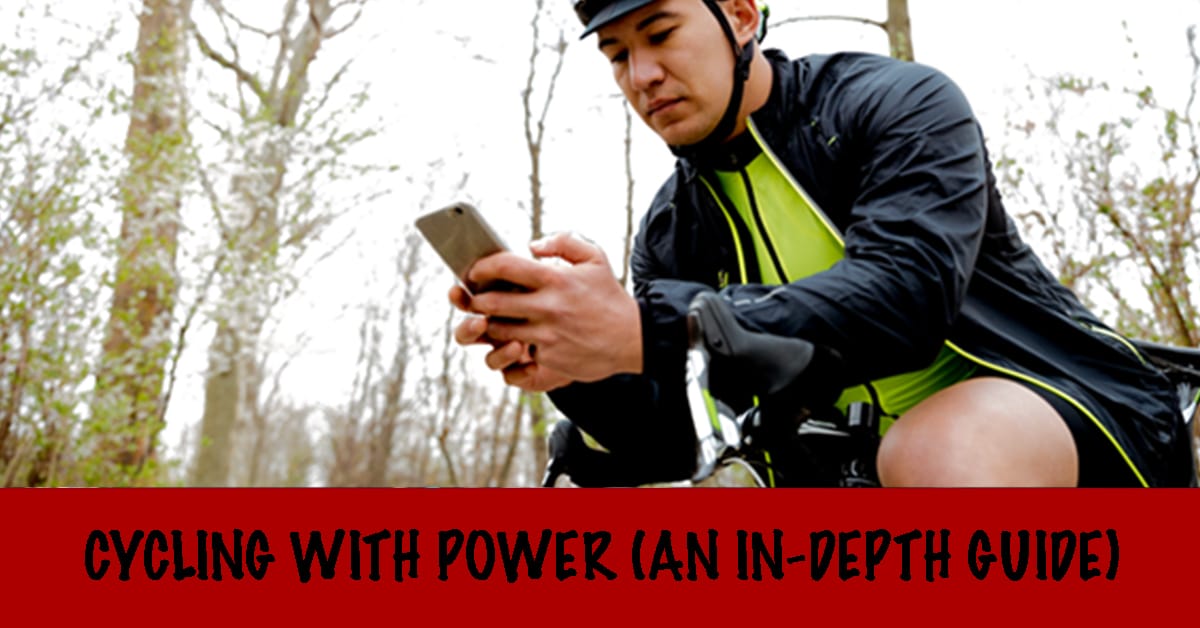Cycling With a Power Meter (an in-Depth Guide)

Power Meters have revolutionised cycling by giving cyclists an accurate measure of their output.
Before Power Meters, cyclists would have to gauge their performance based on speed. This is an unreliable way to measure performance as it is easily affected by outside variables such as wind!
This in-depth guide will help you to train using a Power Meter, we’ll look at:
Understanding Cycling Power
Power meters measure your cycling output using Watts. This will provide an accurate measure of your cycling power output; or how much force you are putting on the pedals.
This is a better way of measuring cycling performance than speed as it is not affected by terrain or wind. Your average speed can be different on the same course on a windy day, meaning you have to produce more power to move at the same speed. By measuring your power output, you can track your performance no matter what the weather or terrain you ride on.
Before power meters, cyclists would train using heart rate and heart rate zones. Heart rate monitors only look at your body’s response to exercise and not your physical output. So although useful, heart rate alone won’t give you an accurate picture of your cycling performance.
Measuring both your output (power) and your bodies response to the output (heart rate), gives you an accurate picture of your performance over time.
For the more technically minded; cycling power is calculated as follows:
Power = Torque x Cadence
In other words:
Power equals the force you put onto the pedals multiplied by the speed you spin the pedals
Power meters measure torque using a strain gauge with cadence (or angular velocity) measurements differing depending on the type of power meter used.
How to Measure Cycling Power
In the last 10 years, it’s become increasingly easy and affordable to measure power output. You can measure your power on both your bike and using indoor trainers.
There is a range of power meters available, each has different benefits and drawbacks.
How to Measure Cycling Power
In the last 10 years, it’s become increasingly easy and affordable to measure power output. You can measure your power on both your bike and using indoor trainers.
There is a range of power meters available, each has different benefits and drawbacks.
Types of Cycling Power Meter
1. Pedal-based Power Meter
Pedal-based power meters measure force from your pedals. The beauty of a pedal power meter is that it is easy to install and can be quickly changed from bike to bike.
You can get a one and two-sided pedal power meters. A one-sided power meter measures the power from one leg and then doubles it, these are usually cheaper. A two-sided pedal power meter measures both left and right legs, although more expensive, this is more accurate and allows you to see if one leg is weaker than the other.
2. Crank power meters
- Crank spindle
- Crank spider
- Chainring
3. Hub Power meters
4. Indoor Trainers
Direct drive turbo trainers can measure your power. Similar to a hub power meter, they measure the power at the cassette.
They can be a good starting point into training with power and an accurate power measurement if you are using training software like Zwift or TrainerRoad (check out our TrainerRoad review here)
Software to use with a Power Meter
Golden Cheetah
TrainingPeaks
Training peaks seems to be a favourite among pro-cyclists. The software combines a range of short and long term measurements to give you a Training Stress Score that a lot of coaches now rely on.
At the core of TrainingPeaks software is the Training Stress Score – a measure of stress originating from the platform and now used by a range of others.
What is Training Stress Score?
Training stress score (TSS) is a measure of the intensity and volume of training used by cyclists to quantify the amount of stress placed on the body during a ride. The score is calculated by multiplying the duration of the ride by the intensity of the ride and is then divided by the average heart rate for the ride. The resulting number is a measure of the rider’s intensity and volume of training and can be used to compare the training load of different riders.
TSS is a useful tool for cyclists to monitor their training, as it can help to identify when they are overtraining or undertraining. It can also be used to compare the training load of different riders and to determine how hard a rider should be training in order to improve their performance.
There are a number of factors that can affect a rider’s TSS, including the intensity of the ride, the duration of the ride, the rider’s weight, the terrain, and the weather. In general, longer and more intense rides will result in a higher TSS.
Cyclists can use TSS to help them plan their training and to monitor their progress. By tracking their TSS over time, they can ensure that they are not overtraining or undertraining and that they are consistently putting in the right amount of work to improve their performance.
Garmin Connect
Key Power Meter Terms
Functional Threshold Power
Functional Threshold Power (FTP) is the amount of power you could theoretically generate for one hour if you pushed yourself to the limit. There are ways to test your FTP without having to push yourself for an hour – it can be calculated from shorter, hard efforts.
Watts
Watts (W) is the unit used to measure power.
Cadence
Cadence is how fast you peddle. Usually expressed in RPM (revolutions per minute). If you are cycling at a cadence of 90 RPM – you are turning the peddles 90 times per minute.
Power to Weight Ratio
Your power to weight ratio is how much power you can generate per kilogram of weight. A higher power to weight ratio is generally better.
Average Power
Average power is the average amount of power you produce over a set amount of time. For example – if you rode for 60 minutes and averages 200 w, your average power would be 200w.
Max Power
Your maximum power is the maximum amount of power you were able to output on a given ride.
How to Train With a Power Meter
If you’ve been cycling for a while, you will no doubt have an idea of how to train and how to improve. We won’t go into the finer details of this but will look specifically at how you can train with power to maximise your cycling gains.
Everyone has different goals and aims when it comes to cycling, so it’s important that you train in a way that helps you to improve, don’t just follow what you read online!
Measure Your Baseline Fitness
The first thing you need to do is work out how fit you are. For endurance cyclings, the best way to do this is to measure your functional threshold power (FTP). Your FTP is how hard you could ride for one hour if you went all out.
The good news is that you don’t have to cycle flat out for one hour to measure this. If you’re using an indoor trainer, most software will have an FTP test workout you can do. The tests are usually broken down into short intervals of a few minutes where you will cycle to your absolute limit. This is then used to calculate your FTP.
If you want to test your FTP on the road, this is how to do it:
20 Minute FTP Test
- Warm-up for 10 minutes – at a comfortable cadence.
- 3 x 1 minute fast intervals – pushing yourself to open up your legs.
- 1 minute easy.
- 5-minute fast spin – keeping your cadence at around 90 RPM
- Ride for 5 minutes at your maximum effort.
- Ride easy for 10 minutes to recover – don’t push yourself!
- Ride for 20 minutes of maximum effort.
- Cool down for at least 10 minutes using steadily decreasing cadence.
- Take the average power output measured from Step 7 and multiply it by 0.95.
Example: If you average 200 watts for 20 minutes your FTP would be 190 watts.
Try to keep your effort across the 20 minute period as consistent as possible. The more you test your FTP the easier it will become to do this.
If you use a newer Garmin, it may calculate your FTP for you, it tends to be pretty accurate from our tests!
Training Zones
Training zones are ranges of power measured as a percentage of your FTP. If you’ve trained with a heart rate monitor, you’ll be familiar with the concept of training to zones.
Working to training zones is effective because the zones change as your FTP improves. This means you can consistently overload your muscles within parameters that will help you to improve.
Different coaches have different zones but most are similar. One of the most used is Dr Andrew Coggan’s power zones, there is a great in-depth article about them here.
| Level | Name | Average Power | Average HR | Perceived Exertion |
| 1 | Active Recovery | <55% | <68 | <2 |
| 2 | Endurance | 56-75% | 69-83% | 2-3 |
| 3 | Tempo | 76-90% | 84-94% | 3-4 |
| 4 | Lactate Threshold | 91-105% | 95-105%(may not be achieved during initial phases of effort(s)) | 4-5 |
| 5 | VO2 Max | 106-120% | >106% | 6-7 |
| 6 | Anaerobic Capacity | >121% | N/A | >7 |
| 7 | Neuromuscular Power |
N/A | N/A | * (Maximal) |
Use Software to Track Your Recovery and Improvement
As Power is a measure your physical output, it’s the best measure of your improvement. The weather can be terrible, you can spend the day riding into a headwind at half your normal speed but if your power output has improved, you are getting fitter. This is an amazing motivational tool, as you see the results of your work and not the results of the weather.
By measuring your power output and heart rate, you will begin to notice trends. If your heart rate is consistently lower for a set power output – its reasonable to say your fitness is improving.
Tweak Your Training Based on Your Results
The more data the collect the easier it is to spot trends. As you learn to properly analyse your data, you will start to understand what works well for you and what doesn’t.
Summary
Training with a Power Meter is the best way to track your cycling improvement. As you begin to measure your power, you’ll start to learn more about how to train using power. This is just a brief introduction!
The most important thing is to enjoy your training, if it all becomes about numbers – you’ll begin to lose motivation when the numbers don’t move as quickly as you’d like.
Mind - Most Recent
The Benefits of Reading: How to Make Time for Books in Your Busy Life
The Power of Positive Thinking
Unleash the Power of Marginal Gains: How Small Improvements Can Lead to Big Results
12 Life-Changing Books for a Year of Personal Development
9 Steps to Supercharge Your Productivity
The Ultimate Guide to Deep Work
The Seven Habits of Highly Effective People by Stephen Covey

0 Comments